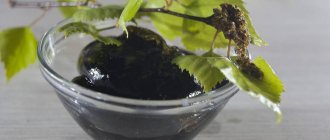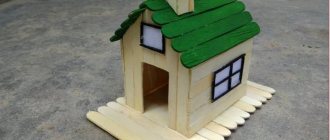Firstly, having a mixed hive for a variety of insects on the site corresponds to the mainstream, because the fashion for environmentalism has moved from residential premises to landscape design.
Secondly, many insects are very useful for the garden, flower beds and beds. They destroy small but voracious pests much more effectively than agricultural chemicals.
Finally, a house for the necessary boogers is a cute, unusual attribute that can decorate a site and become its highlight.
But, in fact, what kind of residents is this building designed for?
Which insects should be attracted to the site?
Honorary tenants in such “dormitories” are well-known ladybugs. They are reliable helpers in the fight against spider mites, aphids, mealybugs, whiteflies and scale insects.
Red seven-spotted ladybugs
True, it should be remembered that only one, the most common type of ladybird, deserves “registration” in the house - red seven-spotted ladybugs. And not only because these bright bugs are better at killing pests.
Remember the children's saying “ladybug, fly to the sky”? It has very ancient roots: the Slavs considered the speckled cow to be the messenger of the goddess of fertility; in many cultures, the scarlet bug with black spots is a living talisman, a symbol of good luck.
It’s also good to attract hoverflies to your site - flies that look like bees. Their larvae feed on aphids and even small caterpillars.
Turuns also feast on caterpillars; lacewings, which destroy aphids, will also be useful. And tiny Trichogramma are indispensable for protecting garden and vegetable crops from cutworms, moths, codling moths and cabbage whites.
And with the help of Trichogramma, almost 70 species (!) of gardening “saboteurs” are neutralized.
This is what Trichogramma looks like
How can they help?
Our harvest depends more on the work of beneficial insects than we think. Pollination is more or less clear: bees , bumblebees , wasps and other workers fly from flower to flower, transfer pollen, and help plants form the ovaries of fruits and berries that we love so much. But that's not all! Many insects fight every day with our worst enemies: aphids, moths, weevils, spider mites and others. Who are these little warriors?
- ladybug - destroys aphids, mites, scale insects, psyllids;
- ground beetle - in 1 season, 1 beetle eats more than 300 caterpillars;
- hoverfly - the adult drinks nectar, but the larvae feed on aphids, spider mites and eggs of pests;
- lacewing - its larvae readily deal with aphids and mites;
- stink bugs - eat the eggs of butterflies, whitefly larvae, thrips, aphids and spider mites;
- parasites - there are many of them, but all types destroy the eggs of pests, their larvae and the insects themselves.
Each insect needs to create suitable conditions. In a word, such neighbors will be very useful to us, which means we should make sure that they settle on the site seriously and for a long time.
What to build a beetle abode from?
For the base, it is better to take a plywood box or an unnecessary wooden box. An old birdhouse equipped with a canopy will also work. Fillers serve as “rooms” in the house. For this purpose, planks and chips, dry branches, straw tufts, bark, cones, clay shards, moss and corrugated cardboard are used. And also necessarily hollow objects - reed tubes, bricks with holes, drilled logs.
House for insects
Hotels for insects
We are launching a new blog on Myslo - about the dacha and garden. Tula landscape designer Lyudmila Konyakhina will share her tricks and wisdom with us. Do you have any suggestions or wishes? Do you want to receive a competent answer from a specialist? Call tel. 8−910−945−88−52, write to the VKontakte group “Lyudmila Konyakhina School of Design PRO Landscape”.
Every self-respecting gardener, at the first signs of awakening in the orchard, thinks about protecting it from harmful insects. And the first thing that comes to mind is chemical treatment. I wonder what our ancestors did in such a situation? Maybe the now fashionable trend of attracting beneficial insects to gardens is the answer to the question asked? I propose to follow a positive example and build a “hotel for insects” at your dacha.
In Europe, owners of garden plots place special houses - shelters for insects, like nest boxes for birds.
They are very simple to make, and some “models” will not only help protect the garden from pest invasion, but also decorate it. Bricks, old boards, straw, bamboo tubes - you don't need anything special. Knowledge of the habits of beneficial insects and imagination will turn old trash into designer objects.
Who needs to be attracted to the garden? First of all, ladybugs. Everyone has known this little bug since childhood. But not everyone knows that seemingly harmless creatures are insatiable predators who constantly destroy aphids, and their larvae are generally terrible gluttons. In some countries, these insects are specially propagated and sold to gardeners and gardeners. Several dozen ladybugs can cause significant havoc among aphids in a short period of time.
Another terrible enemy of aphids is an insect called the lacewing. As an adult, it looks like a moth with delicate wings and sparkling eyes. Due to its predatory nature, the lacewing is sometimes called the “aphid lion.” Its slightly grown larva is even covered, like a fur coat, with a layer of sucked aphid skins; they simultaneously serve it for camouflage and protection from the rays of the sun.
And also hoverflies, solitary bees, bumblebees, centipedes, earwigs. There are many beneficial insects, and they will help our garden.
We will need: several strong planks for the frame, pieces of bark, hollow bricks, hollow plant stems, pine cones, broken and unbroken clay pots, straw, moss, hay, tow, small logs and anything else that requires enough imagination. The main thing is that all materials are natural.
The first stage of construction is the construction of the frame. Size and shape as you wish. The only thing that matters is the depth of the structure: 20-30 cm is quite enough, and the presence of a roof, which is designed to protect from bad weather. Don't skimp on partitions: let the bugs have many rooms.
The second stage will be filling the compartments with prepared materials. Unleash your imagination!
Where to install the house? Strictly speaking, insects need a house for wintering, so you should not hang it at a great height. It’s good if in winter he finds himself under a warm winter blanket, and for this, 20-30 cm from the ground will be ideal. You should choose a quieter place so that you do not disturb the residents, and they do not disturb you. Don’t expect the building to be inhabited right away: the insects need to first take a closer look at it and get used to it, to understand that the place is safe. Advice: you should not paint the design structure with bright colors; if you treat the wood for durability, then use stain in natural shades.
In the spring-summer period, beneficial insects need not so much housing as nutrition, so to attract them they use plantings of plants rich in nectar.
If, nevertheless, your choice remains with the chemical. processing, remember: with the mass destruction of pests, an entire army of useful ones also innocently perishes. It’s worth at least trying to maintain the fragile natural balance in your garden, isn’t it?
The gallery shows options for “filling” a hotel for insects, as well as the process of creating it.
Gallery
show all photos
Principles of building a house for insects
The future “hotel” must be divided into sections so that each type of bugs and flies has its own “living space”.
The fillers are fastened together with glue so that they stick together without succumbing to shaking and gusts of wind. The surfaces inside should alternate with voids and crevices, one texture changing into another: wood into moss, moss into ceramics. This is both convenient for future settlers and looks beautiful from the outside.
The finished house is reinforced with wire or nails. Don’t forget also about a canopy that will cover the building from rain and snow - for this, a piece of plywood protruding beyond the edges is nailed on top.
To prevent the “new settlers” from becoming easy prey for birds, it is recommended to wrap the structure with a mesh with holes sufficient for large insects.
Finally, the building is attached to a stump, a fence, or an earthen mound. It is better to choose a place for it that is protected from drafts and sun, but open to view, because a neat, colorful house is a worthy decor for the site.
Remember that the “hotel” for insects can be of absolutely any shape, color, with any natural filling; You can involve children in its construction, show your artistic inclinations and architectural imagination.
Building your own insect hotel is very easy
There are as many types of hotels as you want in sizes, shapes and materials. Such structures are already on sale in garden stores or on the Internet. But it is very easy to make such a hotel yourself, so we are going to offer you a simple model with four floors and an attic, using recycled materials as filling for the house, which you can find on the farm.
Place
Build your hotel right where you decide to install it. Once the floors are full, they may weigh too much to carry.
To avoid humidity and attacks from certain predators, place the structure at least 30 cm above the ground.
The hotel should be protected from the wind and face south. It will be more effective if it is near the garden or near flowers that attract these insects.
Insect hotel structure
- Cut some pallet boards so that the 40 x 40cm drawers open from the front and back. The height of the floor is approximately 10 cm. Secure the shelves together with screws or nails.
- Each floor can be left open or divided into two or three parts using vertical boards as walls.
- Cut two slightly wider boards, about 45 cm, for the roof. Attach them to the structure with the sides touching against each other, forming a 90 degree angle. You can cover the roof with slate to make the house more waterproof.
- At the back of the structure, you can nail coop mesh to hold the "stuffing" of each floor.
Filling the insect hotel
We fill one of the floors with thick branches or small trunks, about 4-5 cm thick and 40 cm long (structure depth). In large branches we drill three or four holes of different diameters to accommodate insects of different sizes. The branches should fit tightly.
On another floor you can do the same thing, but with a cane or bamboo, also of different diameters. This will be an ideal home for wasps, bees and ladybugs.
On the top floor, in the attic, we can place clay flower pots with straw or cardboard cylinders, folded so that there are nooks and crannies between the folds.
The contents of the house can be very diverse: pieces of bark, reeds, clay blocks or bricks filled with earth and hay, straw, cardboard, old bricks, thorny stems.
A wonderful luxury hotel for a wide range of grateful guests who will be happy in their new home.
Rules for operating a “hostel” for insects
- The best time to install it is late spring.
- Different insects prefer different temperatures, so a smart option is to place the house where it will be sunny half the day and shady half.
- A “hotel” for bugs can also be built right in the wall - for example, in a niche or in a hole that formed in the fence after several bricks fell out.
- To complete the house, it is better not to use plastic tubes, as well as materials coated with paint or varnish. This filling will promote moisture retention and subsequently the development of fungus. For the same reason, fresh grass and leaves are not placed inside.
- In the hot summer, place a “pool” - a container of water - near the house.
- To attract bees, bumblebees, butterflies and other insects that feed on nectar to your new building, plant and sow different flowers nearby. Or place the house in the center of the flower bed.
- At the end of summer, do not forget to clean and repair the house. And also change fillers as necessary.
Many people will have a question: where is the confidence that beneficial insects will settle in the built “apartments”? Will pests get in there too?
Indeed, unwanted guests are also not allowed to enter the mini-house. But ideal conditions created for beneficial insects will very quickly increase their population, and any pest will not stay in the “hotel” for more than a few hours.
What are insect houses?
To attract wild bees and other beneficial insects, there should be nectar-bearing plants around the site: willow, wildflowers, oregano, phacelia, clover, dill and others.
Next, you need to build houses for insects.
You all know when in the spring we all go together to make and install birdhouses, titmouses and bird feeders. Those. We have learned to attract birds and take care of them. We understand that birds are our helpers.
This is how you need to make houses (sort of hotels) for insects. Thus, we attract them to our garden, help them survive the winter in unfavorable conditions, and raise the necessary offspring to maintain the population.
Abroad, similar hotels are being built in many national parks and botanical gardens. In Russia, not enough attention is paid to this.
What is a bug hotel?
A house for beneficial insects, a hotel for beetles, or an insect house is any special structure, a small accumulation of materials or a house in which beneficial insects, honey plants and other enemies of garden pests - lacewings, ladybugs, wasps, hoverflies, ground beetles, etc. This is a comprehensive solution to the problem of attracting beneficial insects to your site and preserving their population in nature.
Universal cute houses, which are actually a warehouse of materials where beneficial insects can arrange their homes, are considered among the objects of small architecture, along with garden sculpture or gazebos. They really can turn into a modern, stylish and very original garden decoration. Each insect house is unique in its own way and will become a bright individual touch in the design of the garden as a whole.
Hollow branches and holes drilled into the log for beneficial insects. © shastan
Such hotels are traditionally given the decorative shape of a house, similar to birdhouses, but of a larger size, filling the interior space with floors of cells in which insects can live. But it is not necessary to build a house. You can use old boxes, unnecessary old containers for plants, leftover boards, pallets and just bricks with cavities-holes.
Materials can be folded into a pyramid, laid out in the form of a wall, built into original structures, or made into a full-fledged frame of a house or cottage. The main thing is that the hotel has a roof and walls that will serve as reliable protection from wind and precipitation. It all depends on your imagination and time. And, of course, the desire to create not just a functional, but also an attractive object that will become a real decoration of the site.
In fact, even modest bundles of brushwood, specially laid out, can be called a hotel for insects. But usually they go much further in their designs, realizing their fantasies and tastes. Most often, hotels are made of wood, but any non-synthetic materials will do (and the wood you should choose is not coniferous).
You can make a full-fledged house with rooms, or you can simply make a triangle out of boards, dividing the internal space into sections and sections with partitions. By placing in each zone inside the hotel different materials in which insects usually live, from porous stone and brick to brushwood and bark, selecting filler with holes of different sizes, you will create all the conditions so that over time bees and other beneficial insects will master such a house and turned it into a real shelter under a roof.
To protect against birds, the house is sometimes covered with netting on top.
A house for beneficial insects, made with your own hands, from scrap materials. © Janet Roberts











